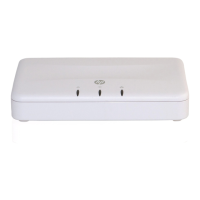802.11n best practices 53
802.11n clients face the same problem as described for 802.11g clients. Legacy a/b/g clients
cannot detect the High Throughput (HT) rates that 802.11n uses. To avoid causing excessive
collisions, 802.11n clients must use the same protection mechanisms when a legacy client is
present. Even the most efficient protection mechanism (CTS-to-self) causes a substantial decline
in throughput. Performance can decline by as much as 50 percent. The 802.11n clients can
achieve maximum data rates only when the legacy clients are not present.
Compatibility modes
See Basic settings on page 55 for a list of supported modes.
Modes that support multiple 802.11 standards are referred to as compatibility modes.
IEEE 802.11b/g/n is the default mode.
For compatibility modes that support 802.11n clients, the M210 advertises protection in its
beacon frames when legacy clients are associated or operating on the same channel. This
alerts the associated 802.11n clients to use protection when transmitting. The M210 also uses
protection when necessary while sending HT data.
Compatibility modes should be used when legacy clients are present in the network. HP
recommends IEEE 802.11a/n or IEEE 802.11 b/g/n as the typical operating mode. Both modes
allow for all wireless clients to connect and they use protection to avoid causing interference.
IEEE 802.11n (5 GHz) and IEEE 802.11n (2.4 GHz)
HP refers to these two modes as Pure-n. When the M210 radio is in either of these modes, it
will not allow non-802.11n clients to associate. Legacy clients can see the M210, and may
attempt to associate, but they will be rejected. The M210 makes this determination based on
information on supported capabilities that the client presents during its association request. If
the client does not indicate support for 802.11n capabilities, it is not allowed to associate.
In these modes, the M210 will not use protection when sending HT frames to associated clients.
If legacy APs or clients are using the same channel, this may lead to collisions. In the 5 GHz
band, this will probably not be a common problem since the band is not heavily used. In the
2.4 GHz band, however, this mode may cause serious performance deterioration for everyone
on the channel (both the 802.11b/g and 802.11n clients).
The M210 will still signal associated clients to use protection when they send data. The M210
does this via a field in the beacons that it sends. So clients sending data to the M210 will use
protection, but data sent from the M210 will not be protected.
Note Some people may refer to this mode as Greenfield, which is not correct. Greenfield is an
802.11n-specific preamble. The M210 does not support this preamble and therefore does not
support Greenfield mode.
The Pure-n modes can be used when there is no legacy wireless traffic present in or around the
premises on the channels that will be used. All client devices must support 802.11n.

